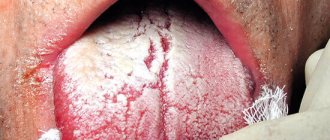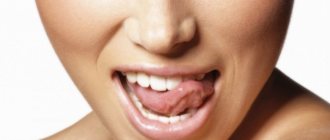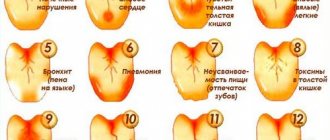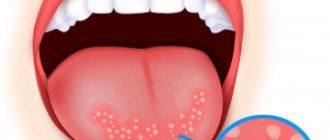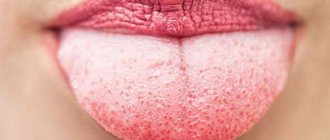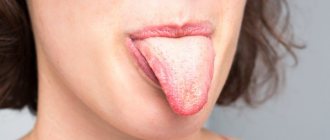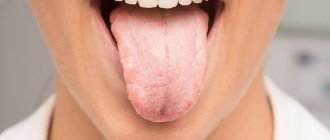Sore throat - white coating on the tongue
White coating on the tongue can occur normally in healthy people.
It usually appears in the morning as a whitish sediment without an unpleasant odor. This is nothing more than an accumulation of microbes overnight. Such sediment is easily removed from the surface of the tongue. If plaque is difficult to remove and has an unpleasant odor, this indicates pathology. The cause of this phenomenon may be diseases of the gastrointestinal tract, sore throat, oral infections, dehydration, trauma, cancer, smoking, alcohol abuse, and lack of oral hygiene. White coating on the tongue and tonsils also occurs with sore throat. The nature of the plaque differs depending on the disease.
Plaque in acute tonsillitis
Sore throat is an acute inflammation of the tonsils, which is characterized by a sore throat, swollen lymph nodes, fever and other symptoms. The appearance of a white coating on the tongue indicates fungal tonsillitis, which is a type of candidiasis of the mucous membranes. In recent years, the number of patients has increased, which is associated with the irrational use of antibiotics and corticosteroids.
Acute fungal tonsillitis refers to specific forms of tonsillitis. Less often, white plaque occurs against the background of a bacterial infection, the causative agents of which are staphylococci or streptococci. Fungal tonsillitis is a secondary inflammation caused by fungal infections.
Antibiotics
Previously, we talked about how angina manifests itself and why it occurs in the first place. Since the causative agent is always a pathogenic microorganism, it is impossible to do without the use of antibiotics. Especially if purulent tonsillitis is diagnosed.
In this case, therapy involves the mandatory use of penicillin, clindamycin, clarithromycin or erythromycin. Antibiotics can be used either in the form of tablets or in the form of intramuscular injections.
If the pathology is caused by exposure to a bacterial infection, then you will need to take Biseptol, Flemoxin Solutab or Amoxicillin - well-known and effective remedies.
However, you need to be careful with antibiotics. They can only be prescribed by a doctor after an examination, because an antibacterial agent that demonstrates high effectiveness against some microorganisms may be completely powerless against others.
You don’t need to choose your own antibiotics, otherwise there is a risk of serious harm to your health.
Bacterial
Sore throats caused by bacterial activity are divided into many types depending on the type of bacteria. Let us list and briefly describe them.
- Diphtheritic sore throat - caused by Loeffler's bacillus. Bilateral damage to the tonsils. Malaise when eating, high body heat that does not subside. A common coating, characteristic of diphtheria, in a gray-white shell. The shell is difficult to remove, is continuous, and has a density higher than that of water.
- Scarlet fever - the cause is category A streptococcus, which leaves toxic products of its vital activity - enterotoxins. In addition to the signs of scarlet fever: significant fever, migraines, purple-crimson surface of the tongue, scarlet, pinpoint exanthema on the face, tongue, and torso (to a moderate extent). There is a clinical picture characteristic of the usual forms: painful sensations when eating, formations clogged with pale yellow contents, plaque on hyperemic tonsils.
- Streptococcal tonsillitis - represents a community of commonplace types. Patients experience pain when swallowing. Intense heat. Hyperemia and a pale film on the organs of the pharyngeal ring. White purulent formations are observed in the follicular form. Large areas of pus appear in the lacunar form. Films with fibrinous form.
- Staphylococcal tonsillitis - manifests itself with a multiple increase in the colony of Staphylococcus aureus. The clinic is in many ways similar to the previous type of sore throat. Filmy formations on the surface of the tonsils in the form of small surroundings. Patients experience severe discomfort when swallowing movements. Symptoms are more severe and last longer than usual forms.
- Vincent-Simanovsky tonsillitis - the causative agent is a bacterial bacillus with a spindle and spirochete shape. Formed when a person lacks nutrients (weak immunity). Unilaterally localized damage to the surface and interior of the tonsils. The course of the disease can proceed without an increase in temperature. Gray-yellow formations with ulcers on the tonsils are observed. The patient has a putrid odor from the mouth. Duration from a week to three weeks.
- Syphilitic tonsillitis - as a consequence of replication of Treponema pallidum. A rapid rise in temperature heralds the onset of the disease. Patients often complain of pain when eating. The pathological organism covers one of the tonsils, characterized by hyperemia and hypertrophy. The lymph nodes of the cervical region are also hypertrophied.
Viral
The name makes it clear that the following types of sore throat are caused by various viruses that characterize the disease and methods of its treatment. Let's look at each variety.
- Measles tonsillitis is a consequence of the activity of paramyxovirus. The patient experiences pain in the throat area during swallowing movements, the body temperature is higher than normal, as a result of inflammation of the respiratory system and exanthema on the epidermis. Examination often reveals swelling of the tonsils. Hyperemia can be expressed as spotty or vesicular formations. Lymph nodes are hypertrophied.
- Herpes sore throat, also called mouth blisters, is a painful infection of the mouth caused by Coxsackie viruses. Typically, herpangina is produced by one specific strain of the Coxsackie A virus, but the Coxsackie B virus or echovirus can also become a pathological organism. There is a high probability of getting herpangina in the summer; this fact mainly concerns children. However, there are frequent cases of detection of the virus in adults and adolescents.
- Sore throat with HIV is observed as a consequence of a decrease in the body’s immunity. The patient feels fever, pain when eating, a coating of white-yellow consistency on the surface of the tonsils, which can selectively affect one of the tonsils. The immune system does not cope well with the disease, which causes a protracted course of the disease.
- Sore throat from the herpes zoster virus is accompanied by the appearance of a large number of blistering formations localized in the area of one of the tonsils. Pain can spread to the visual organs and ear, throat, nose. The duration of the illness is from a week to two weeks.
We suggest you familiarize yourself with 3 compelling reasons to go to the doctor if you have alveolitis after tooth extraction
Symptoms of any oral disease
You notice that there is a constant sour taste in your mouth, especially in the morning. After brushing your teeth and after a short period of time, it seems to you that you didn’t brush your teeth at all, since the plaque on your teeth has appeared again, on your tongue, and the smell is unpleasant.
In this case, you need to consult a doctor. First make an appointment with a therapist, let him prescribe the doctors with whom you need to be examined. This is especially true for a doctor involved in research of the gastrointestinal tract. Usually problems with the appearance of unpleasant plaque are associated with the intestines or stomach.
Once you identify the problem, contact your dentist. He must study in detail and take a picture of the teeth to see if they have been damaged as a result of constant bacterial attacks. If there are no reasons for concern, then you are lucky and periodontal disease has passed you by.
Possible complications
The most common complication of herpes sore throat is serous meningitis. The fact is that the specificity of the Coxsackie virus affects nerve fibers and cells. As a result, the facial muscles may be impaired; this manifestation is a consequence of serous meningitis. Herpes sore throat in adults still passes more calmly, but in a child, if meningitis occurs, this can lead to very bad consequences, even death. Therefore, the treatment of children must be taken very seriously.
Herpes sore throat causes a very rare complication on the liver. And here again everything is due to the peculiarity of Coxsackie, which easily takes root in the liver. If the disease is very severe, it can cause severe complications for this organ.
Another complication may be the development of heart damage. An ECG can reveal this. The main thing is not to start myocarditis, because in this case you can get a chronic form of heart disease. If damage to the heart muscle is detected and treated in time, this complication can be eliminated in a couple of weeks.
Possible causes of yellow coating on the tongue
Probably, many of us have encountered such an unpleasant problem as the appearance of a yellow coating on the tongue. With the appearance of this plaque, an extraneous unpleasant odor “comes.” Of course, this can be dealt with and eliminated, but first we advise you to find out the very cause of the plaque. There are quite a lot of them, so when “self-treatment”, be extremely careful about what you use without any advice or prescription from a doctor.
Possible causes of yellow coating on the tongue:
errors in liver function,
stagnation in the intestines,
unhealthy diet, etc.
Sore throat as a source of yellow coating on the tongue
The tongue with a sore throat is covered with a white coating from the first day, and in severe cases the coating is yellow or brown. Such a coating is difficult to remove. On the second or third day, gradual cleansing of plaque from the tip and lateral surfaces of the tongue begins. In areas free of plaque, the mucous membrane of the tongue has a bright red color with a crimson tint, the papillae are swollen and increased in size. After five to six days, the tongue is completely cleansed and becomes smooth. The filiform papillae are restored, and the tongue takes on its normal appearance.
Symptoms of sore throat in children and adults
Before treating a sore throat and eliminating the white coating on the tongue, you should understand the causes of the disease and its symptoms. Sore throat develops as a result of exposure to fungi, viruses or bacteria.
Pathogens do not immediately lead to the appearance of plaque on the tonsils, but only after the emergence of a favorable environment for the development of the disease. When a person's immunity weakens, microorganisms multiply, and this leads to pain in the larynx and a white coating on the tongue.
The most common signs of a sore throat include:
- pain in the joints;
- increased size of lymph nodes;
- increased acidity;
- sore throat that makes it difficult to swallow food;
- white or yellow coating on the tongue;
- redness of the tonsils;
- weakness;
- heat.
In children, the above symptoms are supplemented by disruption of the digestive system and problems with bowel cleansing. Also, in some children, tonsillitis is accompanied by vomiting and nausea. If such symptoms appear, it is better to immediately visit a doctor so that he can prescribe a course of treatment.
Hybrid
Representations of sore throat with various microorganisms, pathological nature of one of the above groups. These diseases include the stomatitis form of the disease.
- Stomatitis sore throat - this form of the disease is additional to stomatitis and develops along with it. Also, the nature of the course of the disease largely coincides with the underlying disease. The patient can observe swelling of the mucous surface of the mouth, and the surface of the palate and tonsils is covered with small reddish formations (ulcers).
Fungal
Fungus is a stumbling block for diseases in the three types of sore throat listed below. Mycoses of the pharynx are observed, and the disease itself is characterized by the degree of spread of the fungus and its manifestations in the body.
- Candida sore throat - characterized by an acute onset, pathology as a consequence of infection with fungi of the genus Candida. The temperature does not rise. Patients complain of a feeling that there is a foreign object in the throat. Inspection reveals finely scattered, loose, white formations.
- Leptothrixosis tonsillitis is an uncommon condition; the pathology is the Leptothrix fungus. Pharyngoscopy reveals multiple formations with white contents on the inner surface of the pharyngeal cavity. The patient does not complain of any pain, there is no fever.
- Actinomycosis tonsillitis is a rare type of disease caused by radiant fungi (actinomycetes). Manifestation of complications of actinomycosis of the facial and lingual surfaces. When trying to open the mouth, painful sensations are felt. It is difficult for the patient to eat, as bubbles form on the inner surface of the pharynx, preventing the passage of food. Upon examination, you can notice swollen formations on the mucous membrane, which over time burst with purulent contents.
We suggest you familiarize yourself with Temperature after nerve removal - Teeth
Reasons for appearance
The main factors that provoke the appearance of pigmentation:
- allergies to oral hygiene products;
- irritating foods;
- smoking;
- alcohol;
- bite;
- wearing braces;
- dehydration.
Such spots on the tongue appear and disappear in the absence of negative effects on the mucous membrane. The situation with pigmentation that has arisen as a consequence of a developing pathological process is much more complicated. The color, shape and location of the rash helps in making a diagnosis.
How to remove yellow coating on the tongue due to various diseases?
How to remove plaque on the tongue with a sore throat?
Treatment of the mucous membrane of the tongue with angina consists of eliminating symptoms that are caused by increased desquamation of the epithelium and dryness of the mucous membrane. It is recommended that if there is a yellow coating on the tongue, lubricate the tongue mucosa with 1-2% peach oil emulsion, and also rinse the mouth with strong tea after each meal.
In case of severe inflammation of the gums, it is necessary to exclude stomatitis and an allergic reaction. Subsequently, keratoplasty agents should be used: Karotolin, rosehip oil and sea buckthorn oil.
How to cure yellow coating on the tongue due to intestinal congestion?
Plaque can be removed using laxatives.
First, cleanse the intestines, since stagnation in the intestines often leads to various problems with the oral cavity and digestion;
and secondly, it is recommended to take Magnesia or do an enema, as this will be much more effective than herbal preparations, which will last much longer. This means that if you need “emergency ambulance”, we still advise you to take the first method of treating yellow plaque on the tongue.
You need to pay close attention to your diet, see which foods give you a yellow coating on your tongue. Once you figure this out, remove them from your diet altogether.
A yellow coating may appear after dye products - strong tea or coffee, sweets with dyes. Plaque on the tongue is also possible after fatty, fried and smoked foods. In this case, the liver cannot cope with harmful substances in food, resulting in stagnation of bile. To cleanse the liver and prevent plaque on the tongue, you need to go on a diet and eat only healthy foods. Have breakfast with oatmeal or other porridge with milk. Rice also helps normalize digestion.
If you don’t know how to remove yellow coating on your tongue or what diet to follow, then try to eat steamed or boiled food. If after such an improved diet you notice some improvement, then this means that your problem arose precisely because of poor nutrition. This means that you can consider that you have already dealt with the problem of a yellow coating on your tongue.
If, even after following the correct diet and after cleansing the intestines, plaque still forms on the tongue, without hesitation, urgently go to a specialist doctor. After all, if you start to hesitate and advance the disease, the treatment will subsequently be complicated.
What to do and what means to use if there is really a need for it?
If plaque on the tongue is caused by a fungal infection, you must:
- Eliminate the causes of the development of the fungal infection itself - stop taking antibiotics, follow the rules of oral hygiene, normalize your diet, stop smoking and alcohol;
- If eliminating the suspected causes does not produce results, local therapy is prescribed: the use of drugs based on clotrimazole, natamycin, terbinafine and others, rinsing or irrigating the mouth and throat with universal antiseptics: miramistin, hexethidine and others. This therapy lasts several days and the condition of the patient’s oral cavity is monitored. If the plaque disappears, treatment is carried out until it is completely eliminated;
- If local therapy does not produce results, systemic antimycotic agents are used - drugs based on fluconazole (Diflucan, Mikomax), ketoconazole, itraconazole. Only a doctor should prescribe them.
Read more about the treatment of fungal sore throat, we talked in a separate article...
For streptococcal sore throat and for 2 weeks after it, special measures are not required to eliminate plaque. If plaque persists for more than 2 weeks after the end of the illness, you need to visit a doctor for consultation and find out the reasons for it.
It is also useful to read: How many days does a purulent sore throat last?
Dry mouth, which usually accompanies a coated tongue, also goes away as you heal. You can weaken it during the course of the disease by regularly rinsing your mouth with a regular saline solution - it ensures hydration of all tissues in the oral cavity. If a child develops plaque, he needs to be given as much to drink as possible - supplying the body with water maintains the natural hydration of all tissues and integuments of the body.
It is also important to remember that plaque on the tongue is a symptom of a large number of internal diseases, from diseases of the digestive tract to cancer of certain organs. Therefore, if such a plaque is accompanied by any unpleasant symptoms after the end of the sore throat, in any case it is useful to consult a doctor for consultation and diagnosis.
Type of tongue in some disorders of the digestive system.
Conclusions:
- If plaque during or after a sore throat is caused by a fungal infection, it makes sense to wait until antibiotic therapy is completed, and only if after finishing taking antibiotics the thrush does not go away, treat it (and at the same time eliminate plaque) with special means;
- If plaque is a symptom of a sore throat itself, then it does not require treatment and goes away on its own after the end of the disease;
- If plaque develops due to chronic tonsillitis, as a complication of a sore throat, or another disease that is not related to a sore throat and simply occurs simultaneously with it, it is necessary to consult a doctor and, possibly, treat this disease with special means;
- To eliminate dry mouth, it is enough to drink a lot of liquid and rinse your mouth with normal regularity for a sore throat with saline solution or special preparations, including those not based on medicinal herbs.
Drug therapy
The type of medications prescribed depends on the cause of the yellow plaque. You should not take the following pharmacological agents without your doctor's permission:
- Allochol is a choleretic agent. Made from garlic and nettle extracts. If the medicine is chosen correctly, then within a month the tongue should acquire a normal color.
- Probiotics must be taken if the doctor has prescribed antibiotics (Linex, Lactobacterin, Hilak-Forte). These drugs help restore microflora.
- Hepatoprotectors are necessary to support the liver under heavy loads. The doctor may prescribe Heptral, Ovesol, Essentiale Forte or another drug with similar functions.
- Antibiotics are prescribed for the treatment of sore throat (Amoxicillin, Flemoxin, Amotit).
- Anthelmintic drugs are necessary for infection with worms (Pyrantel, Vermox, Fenasal).
- In case of toxic damage, sorbents are needed to eliminate accumulated harmful substances (Polyphepan, Smecta, Filtrum, Enterosgel).
- Antacids are indicated for duodenogastric reflux (Rennie, Almagel, Gastal, Maalox). They help neutralize stomach acid and eliminate unpleasant symptoms such as heartburn.
- Anti-inflammatory drugs must be taken for influenza, ARVI, infectious ENT diseases - pharyngitis, tonsillitis, rhinitis, laryngitis, sinusitis and many other diseases (Ibuprofen, Nurofen, Ketorol).
- If the surface of the tongue is inflamed, then you can use various antibacterial and antifungal drugs (Chlorhexidine, Miramistin, Nystatin, Actovegin).
We invite you to familiarize yourself with Black stripes on the front teeth
What to do?
First of all, you should contact your dentist or therapist. The doctor will prescribe treatment or refer you to a specialized specialist. If it turns out that everything is fine with your health, you should follow preventive measures so that the problem does not return:
- choose high-quality toothpaste and rinses;
- do not eat rough foods too often, as well as sour, salty, spicy foods;
- give up cigarettes and alcohol;
- normalize water balance;
- when wearing braces, follow all the rules for their use and regularly visit the dentist;
- strengthen the immune system.
Spots on the tongue are not such a harmless phenomenon. Their appearance should definitely alert you. A lot of dangerous diseases lie behind pigmentation in the oral cavity.
Complications of sore throat
Complications can be early or late. Early ones (peritonsillitis, peritonsillar abscess, etc.) are caused by the spread of infection to neighboring organs and occur during illness. Late ones appear after 3-4 weeks and are of infectious-allergic origin (articular rheumatism, rheumatic carditis, streptococcal glomerulonephritis).
Attention! Complications of tonsillitis most often occur during self-medication. Only timely comprehensive treatment of sore throat under the supervision of an otolaryngologist will protect you from the serious consequences of the disease!
For blood diseases
Below are the types of tonsillitis that are concomitant with the underlying disease. Let us highlight three main forms, which we will analyze.
- Agranulocytic tonsillitis - according to its external signs, it is classified as ulcerative-necrotic. The patient experiences non-localized malaise, acute discomfort in the throat, and high fever. Ulcerative neoplasms are observed in the area of the tonsils. The oral cavity emits an unpleasant odor. To confirm, tests are prescribed that reveal deviations in the content of blood elements.
- Monocytic tonsillitis is a viral microflora named after the scientists who synthesized it: Epstein-Barr Virus (EBV). For young patients, the disease often results in fever, swollen lymph nodes in the neck, a sore throat, and fatigue. Many people recover within two to four weeks. But the feeling of fatigue does not go away for months. The liver and spleen organs are susceptible to swelling, and there is a percentage chance of spleen rupture.
- Sore throat in leukemia is a concomitant of blood cancer. The patient has difficulty eating. An examination by a doctor should confirm the presence of damaged pharynx organs strewn with small ulcers. Lymph nodes are dilated. There is a strong, unpleasant odor from the mouth.
Types of plaque with sore throat
If a light or black coating appears on the tongue, this indicates the development of an infection in the pharynx. Treatment for sore throat and yellow plaque depends on the type of pathology. The following types of plaque appear on the lining of the oral cavity:
- Transparent. Such a substance can appear not only with tonsillitis, but also with rhinitis or conjunctivitis.
- White. Most often, people suffer from a sore throat with a white coating on the tonsils, which appears only with the follicular type of pathology.
- In the form of curd mass. This thick mass appears in patients who suffer from a fungal form of the disease.
- In the form of light spots. White spots in the throat with sore throat appear quite rarely. Most often they appear on the surface of the tongue during diphtheria.
- Film. A filmy crust with an unpleasant purulent odor appears on the tongue only in the ulcerative form of the disease.
See also
What is dangerous about tonsillitis during pregnancy, causes, symptoms and treatment methods?
Read
For general diseases
Quite often, diseases of the body, of a systemic nature, are accompanied by manifestations of sore throat. One of these diseases that causes a sore throat is allergies.
- Allergic sore throat - characterized by extensive swelling of the organs of the pharyngeal ring and the surface of the mouth. On examination, hyperemia of the pharynx is observed. This form does not provide signs of an increase in temperature or the appearance of a pale film, as in the previously disassembled species. There is a correlation with cases of patient contact with allergens and manifestations of the disease.
Causes of sore throat
The peak incidence of sore throat in children is observed in cold weather; due to sudden temperature fluctuations, immunity is noticeably reduced. Other reasons include: poor nutrition, lack of vitamins and walks in the fresh air.
The tonsils do not perform a protective function; it is very easy to provoke the proliferation of bacteria - just drink cold water. Do not forget that sore throat is contagious, so in this condition you can catch the infection through airborne droplets. In addition, infectious diseases are provoked by:
- pathologies of ENT organs and oral cavity;
- long-term treatment with antibiotics;
- frequent infectious diseases;
- intestinal dysbiosis.
The effect of tonsillitis on teeth
Inflammation of the tonsils has a direct effect on the teeth. An infection located on the tonsils is easily transferred to the teeth. As a result, caries occurs, the tooth begins to decay and inflammation develops. Chronic diseases of the mouth, including tonsillitis, very often cause caries. When a doctor diagnoses tonsillitis, teeth must be carefully protected.
Caries is directly related to chronic tonsillitis. First, the infection transfers to the teeth, and then the carious teeth affect the tonsils. That is why doctors prescribe complex treatment of the oral cavity and pharynx. When tonsillitis is completely cured and the teeth are checked by a dentist, only then is the oral cavity completely healthy.
Prevention
To prevent the inflammatory process in the tonsils from affecting the tongue and teeth, it is necessary to take some preventive measures. If you have tonsil disease, it is important to rinse your mouth with various antibacterial compounds. It is better to use the healing solution 2-3 times a day. It will eliminate the infection developing in the oral cavity.
What tests does a doctor usually prescribe for tonsillitis? Read everything about diagnosing this disease in our article tests for tonsillitis.
Share “What does tonsillitis leave on the tongue and teeth?”
(Visited 1,429 times, 1 visits today)
Temperature
Temperature and a white coating may indicate an incipient sore throat. In this case, patients complain of a coated white tongue, pain when swallowing, general weakness and malaise, as well as fever. The combination of these symptoms provides grounds for diagnosing angina.
With a sore throat, the tongue becomes white and the throat hurts, while the plaque is usually very dense and difficult to remove. Taking certain medications only worsens the condition. Therefore, it is extremely important to ensure oral hygiene, to clean not only the teeth and gums, but also the tongue.
Advice! You can remove white plaque using an ordinary soft toothbrush and toothpaste. Use light circular movements to clean the surface of the tongue, being careful not to damage or scratch it. It is best to do this procedure in the morning before eating, since the plaque consists almost entirely of bacteria, and it is completely undesirable to swallow them.
Clinical manifestations of the disease
A distinctive feature of this form of angina is scanty symptoms. Signs of intoxication of the body are most often absent, body temperature remains within normal limits. The main symptoms are:
- malaise;
- slight weakness;
- headache;
- white plaque in the area of the tongue and tonsils;
- moderate enlargement of lymph nodes in the neck;
- bad breath;
- sore throat;
- pain when swallowing;
- violation of taste sensitivity.
A sore throat plaque looks like sour cream or cottage cheese. If a secondary bacterial infection occurs, it becomes purulent and an unpleasant odor appears. Plaque forms on top of the tonsils, tongue and cheeks. Without proper treatment, fungi spread throughout the entire oral cavity. With angina, the appearance of the papillae of the tongue, which contain taste buds, changes, and their taste sensitivity decreases.
With inflammation of the tonsils, bleeding of the mucous membrane is possible, and in advanced cases, the pharynx and esophagus are involved in the process. The appearance of a white coating is possible due to severe intoxication against the background of bacterial tonsillitis, in this case the symptoms are more pronounced. Upon examination, hyperemia and swelling of the tonsils are revealed, the temperature can rise to 39-40ºC.

